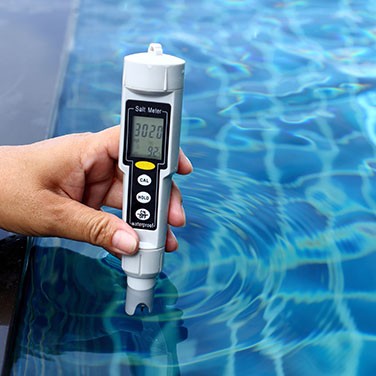Pool Science: Chlorine and Balancing pH
By Kylie Wolfe
We often associate different scents with different seasons and summertime is no exception. Sizzling food on a grill, campfire smoke, and fresh cut grass all give off aromas that trigger our favorite memories. They remind us that school is out and summer is in session.
The scent of a chlorinated swimming pool is yet another example — nothing says summer like a relaxing dip or dive on a hot day. But getting the chemistry right is important for everyone’s health and safety.
Summer Science
Chlorine serves three main purposes: it’s a sanitizer, an algaecide, and an oxidizer. It helps protect swimmers from germs that cause recreational water illnesses (RWI), combating contaminants like urine, sweat, and lotions and preventing things like diarrhea, swimmer’s ear, and skin infections.
When free available chlorine (FAC), an unreacted form of the chemical, is present, it can kill bacteria. But if it has already reacted with other substances, it forms chloramines, also known as combined available chlorine (CAC).
When chloramines are abundant, the result is a strong chlorine odor. Most people assume this smell is a sign of too much chlorine, but in this case, the pool needs more chlorine to fight off and kill germs. When we don’t have the proper balances of FAC and CAC, it can result in eye irritation and the all too common chlorine smell.
Reducing Risk
The production of chloramines reduces the amount of chlorine available to kill germs. This competition makes it difficult to maintain a proper balance and is why regular pool upkeep and personal hygiene is necessary.
If you’re in charge of pool maintenance, be sure to test the water daily at the very least. Some test kits will only measure total chlorine, the combination of FAC and CAC, so find one that will measure for FAC only. This value should fall between 2.0 and 4.0 ppm. It’s also important to keep pH levels between 7.2 and 7.8. Ultimately, proper chlorination will help kill harmful microorganisms, but it can only do so much.
If you’re going swimming, you can also play a part in keeping your favorite swimming spots clean and safe. Infections can spread easily in the pool, through swallowing, breathing, or coming in contact with impurities. Taking a shower beforehand can help wash away sweat and other contaminants. And regular bathroom breaks for children can help discourage them from peeing in the pool.
Safe Solutions
Chlorine can’t do its job effectively when the pool water’s chemical balance gets out of alignment. To address this, shock treatments, or the addition of significant amounts of chlorine at one time, can be used to destroy organic contaminants and resolve odors.
Going swimming should be relaxing, not risky. Anyone who enjoys heading to the pool should share in the responsibility of maintaining it. By doing our part, we can help ourselves and those around us stay healthy and enjoy the summer sun.
